CHAPTER 0
Fundamentals
EXERCISES 0.1 Evaluating a Polynomial
3(1 + 1
3(5 + 1
3(1 + 1
3(6)))) = 2.
1 (a) P (x) = 1 + x(1 + x(5 + x(1 + x(6)))).
P ( 1
P ( 1
P ( 1
3)2 + 1
3)4 + ( 1
3)4 + ( 1
3) = 6( 1
3)3 + 5( 1
3)3 + 5( 1
3)4 + 4( 1
3)3 − ( 1
3) + 1 = 1 + 1
3) = −3( 1
3) = 2( 1
3 + 1 = 1 + 1
1 (b) P (x) = 1 + x(−5 + x(5 + x(4 + x(−3))))
1 (c) P (x) = 1 + x(0 + x(−1 + x(1 + x(2))))
3)2 − 5( 1
3(−5 + 1
3)2 + 1 = 1 + 1
3(0 + 1
3(−1 + 1
3(1 + 1
2 (a) P (x) = 7+x(−3+x(−2+x(6))); P (− 1
2) = 7+(− 1
2)(−3+(− 1
2 (b) P (x) = 1 + x(−3 + x(1 + x(−3 + x(−1 + x(8)))));
2)(−1 + (− 1
2)(−3 + (− 1
2)(1 + (− 1
2 (c) P (x) = 4 + x(−2 + x(0 + x(0 + x(−2 + x(0 + x(4))))));
2)(0 + (− 1
2)(0 + (− 1
2)(−2 + (− 1
2)2(1))) = 81/64.
P (− 1
P (− 1
2) = 1 + ( 1
2) = 1 + (− 1
2) = 4 + (− 1
2)(−3 + (− 1
2)(−2 + (− 1
2)2(2 + ( 1
3 P ( 1
2)2(−4 + ( 1
3(5 + 1
3(4 + 1
3(−3)))) = 0
3(2)))) = 77/81.
2)(−2+(− 1
2)(8))))) = 45/16.
2)(6))) = 29/4.
2)(0 + (− 1
2)(4)))))) = 79/16.
2 + (5 − 2)( 1
2 + (5 − 3)(− 1
2) = 4 + 1
2) = 4 − 1
2 + (−1 − 2)( 1
2 − 1)(1 + ( 1
2))) = 8
2 − 3)(2)))) = 5
2))) = −4
2 + (−1 − 3)(− 1
2 − 2)(3 + ( 1
4 (a) P (5) = 1 + 5( 1
4 (b) P (−1) = 1 + (−1)( 1
5 (a) P ( 1
2(4 + ( 1
5 (b) P (− 1
2(4 + (− 1
6 (a) P (x) = a0 + x5(a5 + x5(a10 + x5a15)). The three multiplications x2 = x · x, x4 =
x2 · x2, x5 = x4 · x are needed, together with 3 multiplications and 3 additions from the nested
multiplication. Total of 6 multiplications and 3 additions.
6 (b) P (x) = x7(a7 + x5(a12 + x5(a17 + x5(a22 + x5a27)))). The four multiplications x2 =
x · x, x4 = x2 · x2, x5 = x4 · x, x7 = x5 · x2 are needed, together with 5 multiplications and 4
additions from the nested multiplication. Total of 9 multiplications and 4 additions.
2 − 3)(2)))) = 41/4
2 − 1)(1 + (− 1
2 − 2)(3 + (− 1
7 The degree n polynomial with base points is P (x) = c1 + (x − r1)(c2 + (x − r2)(c3 + (x −
r3)(c4 + . . . + (x− rn)cn+1))). The operations needed are n multiplications and 2n additions.
COMPUTER PROBLEMS 0.1
1 The MATLAB command nest(50,ones(51,1),1.00001) gives 51.01275208274999,
differing from (x51 − 1)/(x − 1) with x = 1.00001 by 4.76 × 10−12.
c#2012 Pearson Education, Inc.
�
2
CHAPTER 0 FUNDAMENTALS
2 The command nest(99,(-1).ˆ(0:99),1.00001) gives −0.00050024507964763. The
equivalent expression (1 − x100)/(1 + x) for x = 1.00001 differs by 1.713 × 10−16.
EXERCISES 0.2 Binary Numbers
1 (a) (64)10 = (26)10 = (1000000)2
1 (b) (17)10 = (16 + 1)10 = (10001)2
1 (c)
Therefore (79)10 = (1001111)2.
1 (d)
79 ÷ 2 = 39 R 1
39 ÷ 2 = 19 R 1
19 ÷ 2 = 9 R 1
9 ÷ 2 = 4 R 1
4 ÷ 2 = 2 R 0
2 ÷ 2 = 1 R 0
1 ÷ 2 = 0 R 1
227 ÷ 2 = 113 R 1
113 ÷ 2 = 56 R 1
56 ÷ 2 = 28 R 0
28 ÷ 2 = 14 R 0
7 R 0
14 ÷ 2 =
3 R 1
7 ÷ 2 =
1 R 1
3 ÷ 2 =
0 R 1
1 ÷ 2 =
Therefore (227)10 = (11100011)2.
2 (a) (1/8)10 = (2−3)10 = (0.001)2
2 (b) (7/8)10 = (2−1 + 2−2 + 2−3)10 = (0.111)2
2 (c) (35/16)10 = (2 + 3/16)10 = (2 + 1/8 + 1/16)10 = (10.0011)2
c#2012 Pearson Education, Inc.
�
SECTION 0.2 BINARY NUMBERS
3
2 (d)
31/64 × 2 = 31/32 + 0
31/32 × 2 = 15/16 + 1
15/16 × 2 = 7/8 + 1
7/8 × 2 = 3/4 + 1
3/4 × 2 = 1/2 + 1
1/2 × 2 = 0 + 1
Therefore (31/64)10 = (0.011111)2.
3 (a) 10.5 = 10 + 0.5. Integer part: (10)10 = (8 + 2)10 = (1010)2. Fractional part: (0.5)10 =
(0.1)2, so (10.5)10 = (1010.1)2.
3 (b)
Therefore ( 1
3)10 = (0.01)2.
3 (c)
2
3
1
3
2
3
3
7
6
7
5
7
3
7
6
7
+ 0
+ 1
+ 0
+ 1
+ 0
+ 1
+ 1
+ 0
1
3 × 2 =
2
3 × 2 =
1
3 × 2 =
...
5
7 × 2 =
3
7 × 2 =
6
7 × 2 =
5
7 × 2 =
3
7 × 2 =
...
Therefore ( 5
7)10 = (0.101)2.
c#2012 Pearson Education, Inc.
�
4
CHAPTER 0 FUNDAMENTALS
3 (d) (12.8)10 = (12)10 + (0.8)10; (12)10 = (1100)2.
0.8 × 2 = 0.6 + 1
0.6 × 2 = 0.2 + 1
0.2 × 2 = 0.4 + 0
0.4 × 2 = 0.8 + 0
0.8 × 2 = 0.6 + 1
...
Therefore (12.8)10 = (1100.1100)2.
3 (e) (55.4)10 = (55)10 + (0.4)10; (55)10 = (32 + 16 + 4 + 2 + 1)10 = (110111)2.
0.4 × 2 = 0.8 + 0
0.8 × 2 = 0.6 + 1
0.6 × 2 = 0.2 + 1
0.2 × 2 = 0.4 + 0
0.4 × 2 = 0.8 + 0
...
Therefore (55.4)10 = (110111.0110)2.
3 (f)
0.1 × 2 = 0.2 + 0
0.2 × 2 = 0.4 + 0
0.4 × 2 = 0.8 + 0
0.8 × 2 = 0.6 + 1
0.6 × 2 = 0.2 + 1
0.2 × 2 = 0.4 + 0
...
Therefore (0.1)10 = (0.00011)2.
4 (a)
11.25 = 11 + 0.25. Integer part: (11)10 = (8 + 2 + 1)10 = (1011)2. Fractional part:
(0.25)10 = (0.01)2, so (10.25)10 = (1011.01)2.
c#2012 Pearson Education, Inc.
�
SECTION 0.2 BINARY NUMBERS
5
4 (b)
Therefore ( 2
3)10 = (0.10)2.
4 (c)
1
3
2
3
1
3
1
5
2
5
4
5
3
5
1
5
+ 1
+ 0
+ 1
+ 1
+ 0
+ 0
+ 1
+ 1
2
3 × 2 =
1
3 × 2 =
2
3 × 2 =
...
3
5 × 2 =
1
5 × 2 =
2
5 × 2 =
4
5 × 2 =
3
5 × 2 =
...
Therefore ( 3
5)10 = (0.1001)2.
4 (d) (3.2)10 = (3)10 + (0.2)10; (3)10 = (11)2.
0.2 × 2 = 0.4 + 0
0.4 × 2 = 0.8 + 0
0.8 × 2 = 0.6 + 1
0.6 × 2 = 0.2 + 1
0.2 × 2 = 0.4 + 0
...
Therefore (3.2)10 = (11.0011)2.
c#2012 Pearson Education, Inc.
�
6
CHAPTER 0 FUNDAMENTALS
4 (e) (30.6)10 = (30)10 + (0.6)10; (30)10 = (16 + 8 + 4 + 2)10 = (11110)2.
0.6 × 2 = 0.2 + 1
0.2 × 2 = 0.4 + 0
0.4 × 2 = 0.8 + 0
0.8 × 2 = 0.6 + 1
0.6 × 2 = 0.2 + 1
...
Therefore (30.6)10 = (11110.1001)2.
4 (f) (99.9)10 = (99)10 + (0.9)10; (99)10 = (64 + 32 + 2 + 1)10 = (1100011)2.
0.9 × 2 = 0.8 + 1
0.8 × 2 = 0.6 + 1
0.6 × 2 = 0.2 + 1
0.2 × 2 = 0.4 + 0
0.4 × 2 = 0.8 + 0
0.8 × 2 = 0.6 + 1
...
Therefore (99.9)10 = (1100011.11100)2.
5 (π)10 = (3)10 + (π − 3)10
0.14159265 × 2 = 0.28318531 + 0
0.28318531 × 2 = 0.56637061 + 0
0.56637061 × 2 = 0.13274123 + 1
0.13274123 × 2 = 0.26548246 + 0
0.26548246 × 2 = 0.53096491 + 0
0.53096491 × 2 = 0.06192983 + 1
0.06192983 × 2 = 0.12385966 + 0
0.12385966 × 2 = 0.24771932 + 0
0.24771932 × 2 = 0.49543864 + 0
0.49543864 × 2 = 0.99087728 + 0
0.99087728 × 2 = 0.98175455 + 1
0.98175455 × 2 = 0.96350910 + 1
0.96350910 × 2 = 0.92701821 + 1
...
c#2012 Pearson Education, Inc.
�
SECTION 0.2 BINARY NUMBERS
7
Therefore (π)10 = (11.0010010000111 . . .)2.
6 (e)10 = (2)10 + (e − 2)10
0.71828183 × 2 = 0.43656366 + 1
0.43656366 × 2 = 0.87312731 + 0
0.87312731 × 2 = 0.74625463 + 1
0.74625463 × 2 = 0.49250926 + 1
0.49250926 × 2 = 0.98501851 + 0
0.98501851 × 2 = 0.97003702 + 1
0.97003702 × 2 = 0.94007404 + 1
0.94007404 × 2 = 0.88014809 + 1
0.88014809 × 2 = 0.76029617 + 1
0.76029617 × 2 = 0.52059234 + 1
0.52059234 × 2 = 0.04118468 + 1
0.04118468 × 2 = 0.08236937 + 0
0.08236937 × 2 = 0.16473874 + 0
...
Therefore (e)10 = (10.1011011111100 . . .)2.
implies x = 1
7 (f)
7 (h)
2 + 1
8)10 = (93/8)10.
Therefore (110.10)2 = (6 + 2
3. Therefore (10111.01)2 = (23 + 1
3)10 = (70/3)10.
7 (a) (1010101)2 = (20 + 22 + 24 + 26)10 = (1 + 4 + 16 + 64)10 = (85)10
7 (b) (1011.101)2 = (23 + 21 + 20 + 2−1 + 2−3)10 = (11 + 1
7 (c) (10111.01)2 = (24 + 22 + 21 + 20)10 + (0.01)2. Set x = (0.01)2. Then 22x− x = (01)2 = 1
7 (d) (110.10)2 = (22 + 21)10 + (0.10)2. Set x = (0.10)2. Then 22x − x = (10)2 implies x = 2
3.
7 (e)
(10.110)2 = (2)10 + (0.110)2. Set x = (0.110)2. Then 23x − x = (110)2 = 6 implies
2 )10, where x = (0.101)2. Since
(110.1101)2 = (6)10 + ( 1
8(0.1101)2. Set x = (0.1101)2. Then 24x−x = (1101)2 =
(111.1)2 = (7)10 + (0.1)2 = (7)10 + x, where x = (0.1)2. Since 21x − x = (1)2, x = 1,
23x − x = (101)2 = 5, x = 5/7. Therefore (110.1101)2 = ( 13
13, implying that x = 13
4 + 1
7)10 = (20/7)10.
2)10 + (0.0101)2 = ( 13
x = 6/7. Therefore (10.110)2 = (2 + 6
15. Therefore (10.0101101)2 = ( 9
7 (g) (10.0101101)2 = (2)10 +( 1
13
15)10 = (283/120)10.
2 + 5
7
1
2)10 = (48/7)10.
2 + x
8
3)10 = (20/3)10.
4)10 + 1
and (111.1)2 = (7 + 1)10 = (8)10.
8 (a) (11011)2 = (20 + 21 + 23 + 24)10 = (1 + 2 + 8 + 16)10 = (27)10
8 (b) (110111.001)2 = (25 + 24 + 22 + 21 + 20 + 2−3)10 = (55 + 1
8)10.
8 (c)
(111.001)2 = (22 + 21 + 20)10 + (0.001)2. Set x = (0.001)2. Then 23x − x = (001)2 = 1
implies x = 1/7. Therefore (111.001)2 = (7 + 1/7)10.
c#2012 Pearson Education, Inc.
�
8
CHAPTER 0 FUNDAMENTALS
8 (d) (1010.01)2 = (23 + 21)10 + (0.01)2. Set x = (0.01)2. Then 22x− x = (01)2 implies x = 1
3.
8 (e)
(10111.10101)2 = (10111.10)2 = (24 + 22 + 21 + 20)10 + (0.10)2. Set x = (0.10)2. Then
Therefore (1010.01)2 = (10 + 1
3)10 = (10 + 1/3)10.
8 (f) (1111.010001)2 = (15)10 + (1/4)10 + 1
22x − x = (10)2 = 2 implies x = 2/3. Therefore (10111.10101)2 = (23 + 2
Since 23x − x = (001)2 = 5, x = 1/7. Therefore (1111.010001)2 = (15 + 1/4 + 1
(15 + 15/56)10.
8(0.001)2 = (15 + 1/4 + x
8 )10, where x = (0.001)2.
1
7)10 =
3)10.
8
EXERCISES 0.3 Floating Point Representation of Real Numbers
1 (a) ( 1
1 (b) ( 1
4)10 = (0.01)2; fl( 1
3)10 = (0.01)2 =
4) = +1.0 × 2−2.
+1. 0101010101010101010101010101010101010101010101010101 0101 . . . × 2−2.
The Rounding to Nearest Rule says to round down when the 53rd bit is 0.
3) = +1. 0101010101010101010101010101010101010101010101010101 × 2−2.
fl( 1
1 (c) ( 2
3)10 = (0.10)2 =
+1. 0101010101010101010101010101010101010101010101010101 0101 . . . × 2−1.
3) = +1. 0101010101010101010101010101010101010101010101010101 × 2−1.
fl( 2
+1. 1100110011001100110011001100110011001100110011001100 1100 . . . × 2−1.
The Rounding to Nearest Rule says to round up since the 53rd bit is nonzero, and further bits
are nonzero.
fl(0.9) = +1. 1100110011001100110011001100110011001100110011001101 × 2−1.
1 (d) (0.9)10 = (0.11100)2 =
2 (a) (9.5)10 = (1001.1)2; fl(9.5) = 1.0011 × 23.
2 (b) (9.6)10 = (1001.1001)2 = 1.0011001 × 23 =
+1. 0011001100110011001100110011001100110011001100110011 0011 . . . × 23.
fl(9.6) = +1. 0011001100110011001100110011001100110011001100110011 × 23.
2 (c) (100.2)10 = (1100100.0011)2 = 1.1001000011 × 26 =
+1. 1001000011001100110011001100110011001100110011001100 1100 . . . × 26.
fl(100.2) = +1. 1001000011001100110011001100110011001100110011001101 × 26.
2 (d) ! 44
7"10 = (6 + 2
+1. 1001001001001001001001001001001001001001001001001001 0010 . . . × 22.
fl! 44
7" = +1. 1001001001001001001001001001001001001001001001001001 × 22.
3 Note that fl(5) = 1.01× 22. Adding 1 as bit 3, 4, . . . , 52 of the mantissa will not incur rounding
7)10 = (110.010)2 =
error. These correspond to 2−k for k = 1, 2, . . . , 50.
4 Note that fl(19) = 1.0011× 24. Adding 1 to bit 52 of the mantissa, corresponding to 19 + 2−48,
will not be rounded away, and so 48 is the largest such k.
c#2012 Pearson Education, Inc.
�
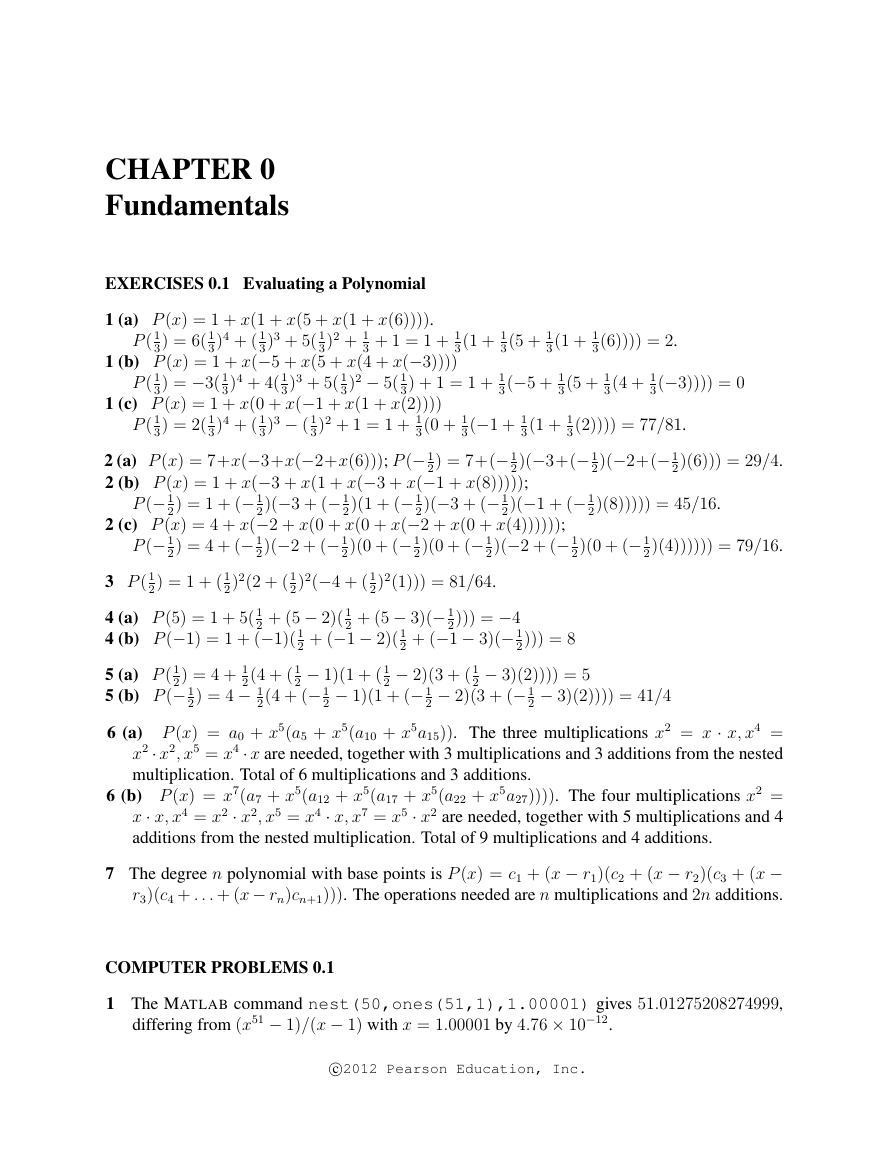
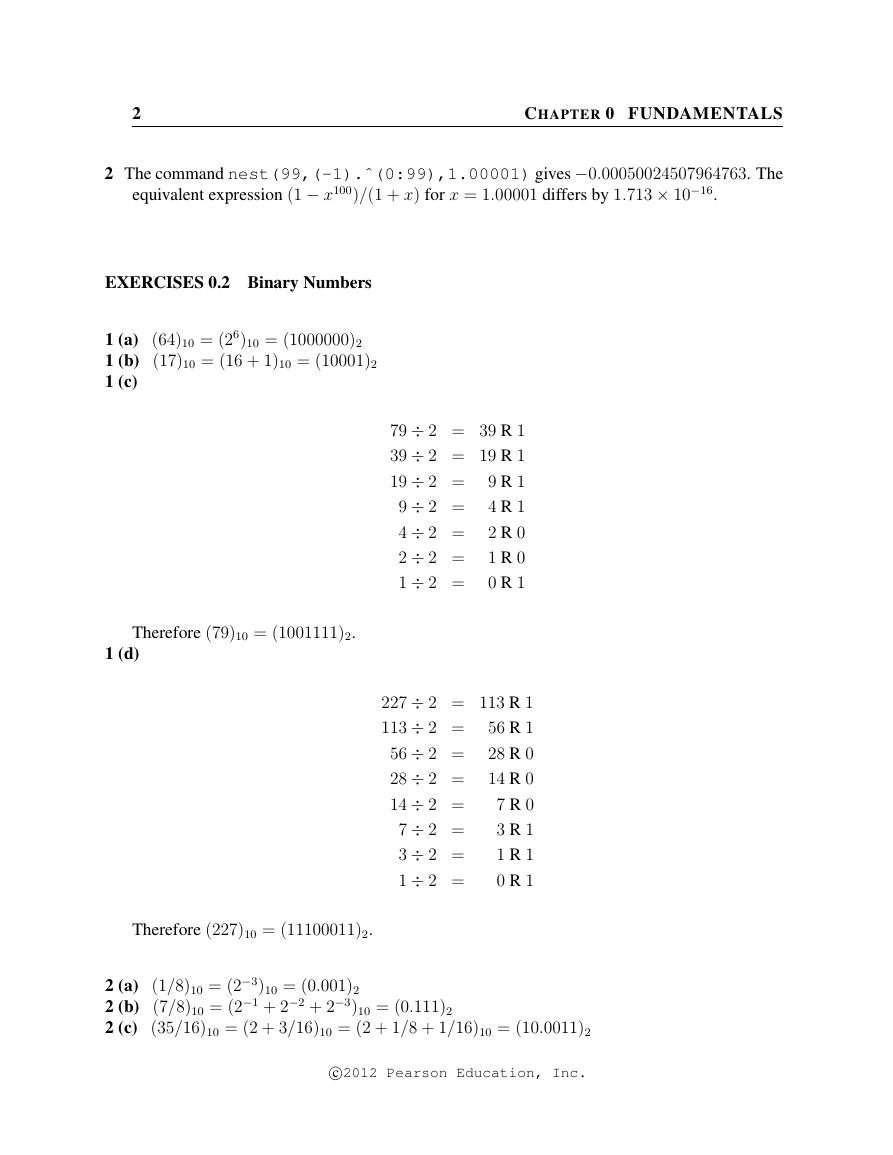
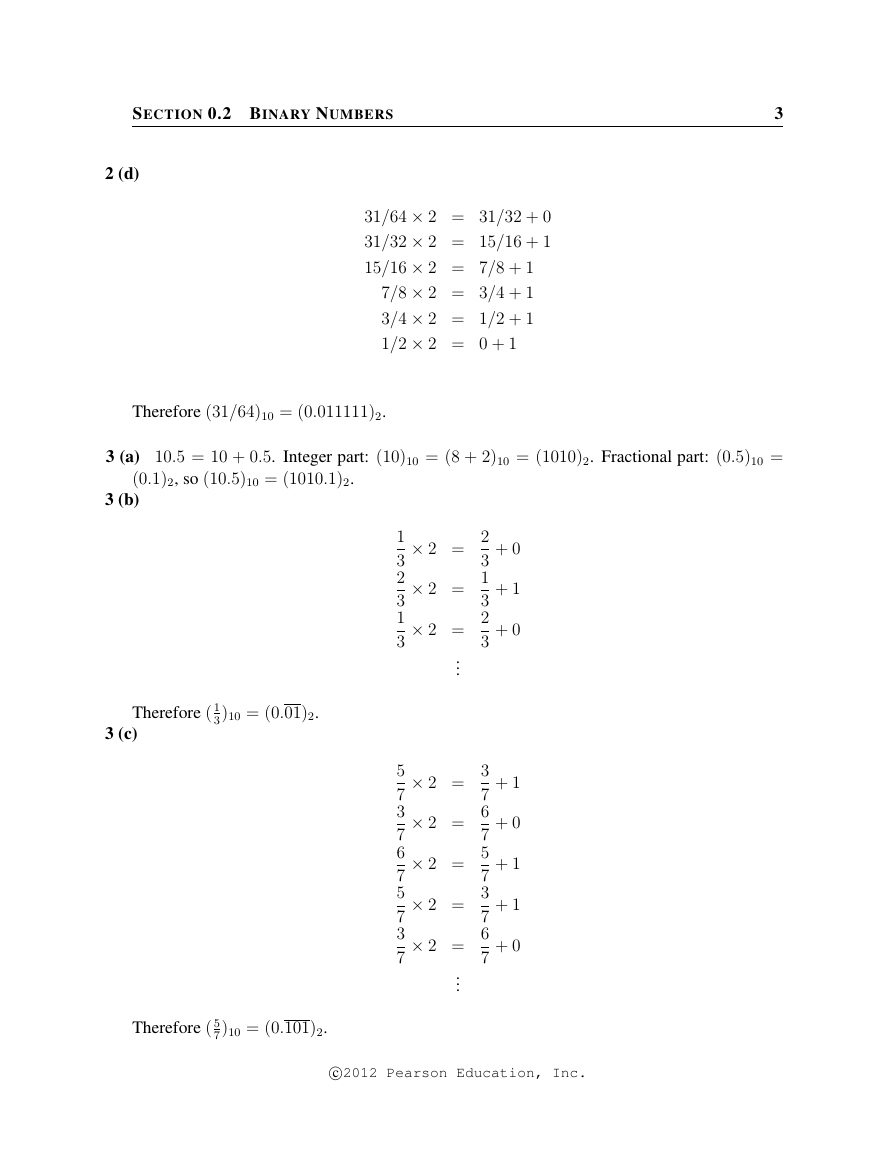
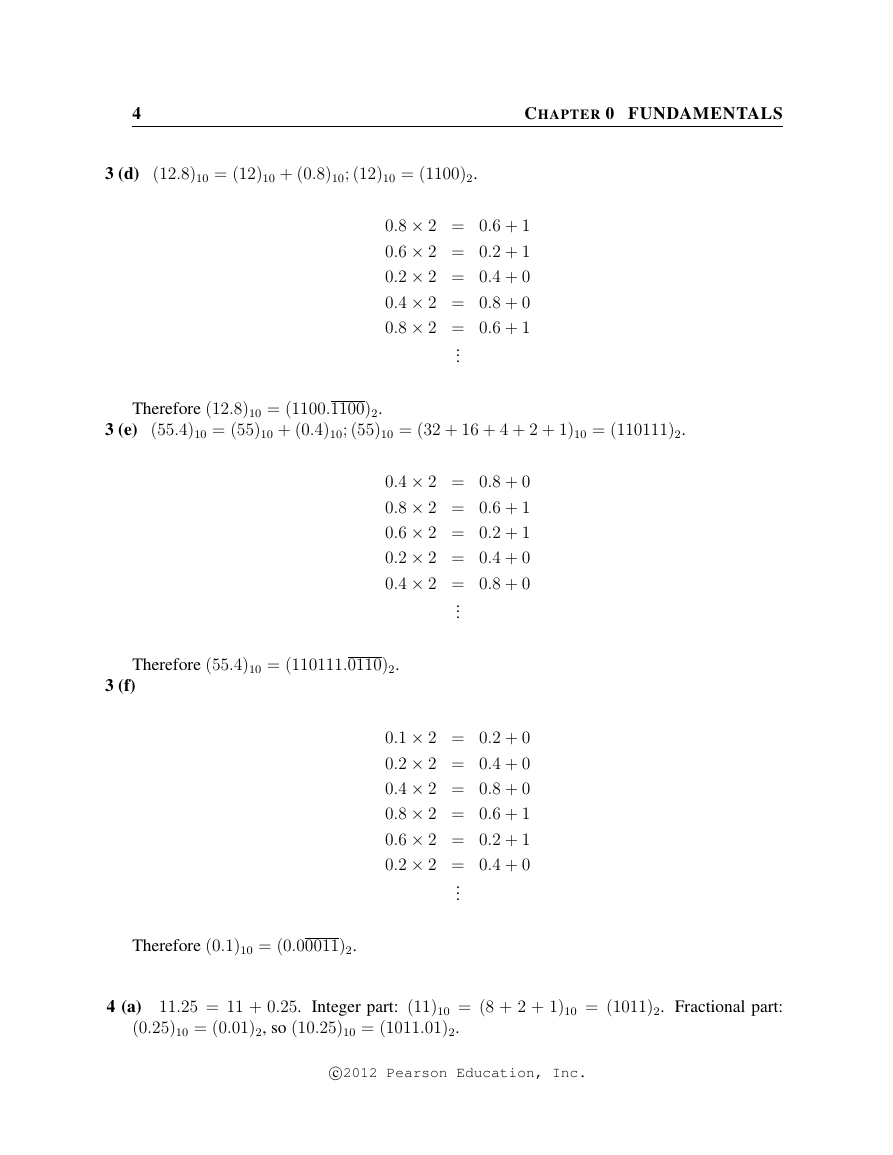
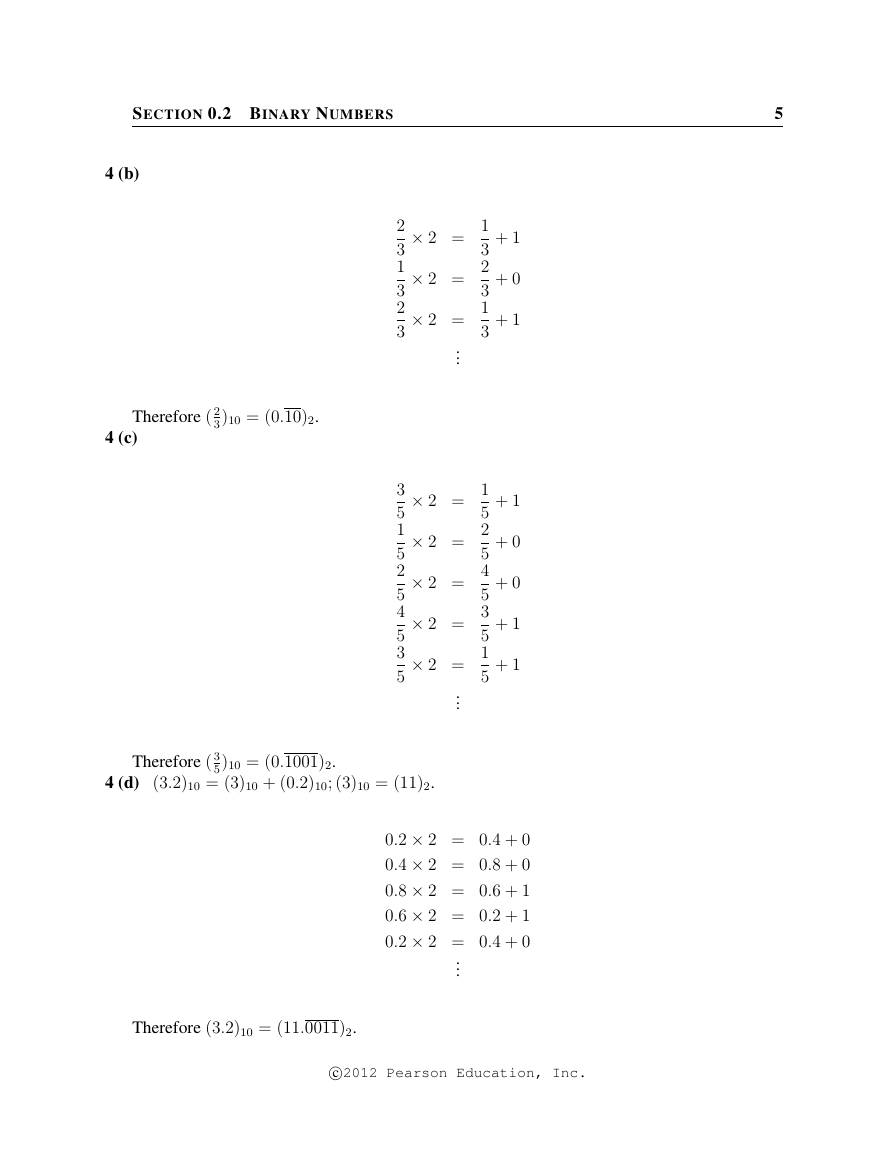
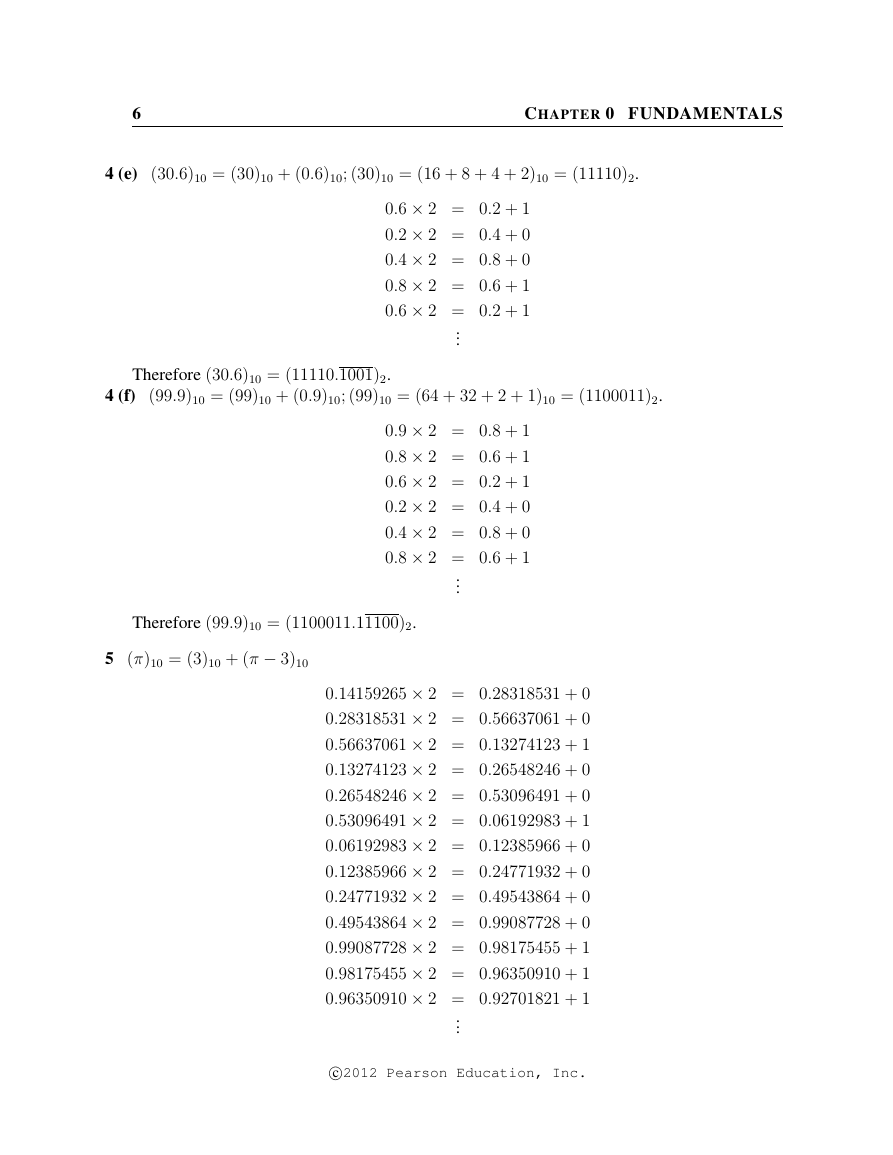
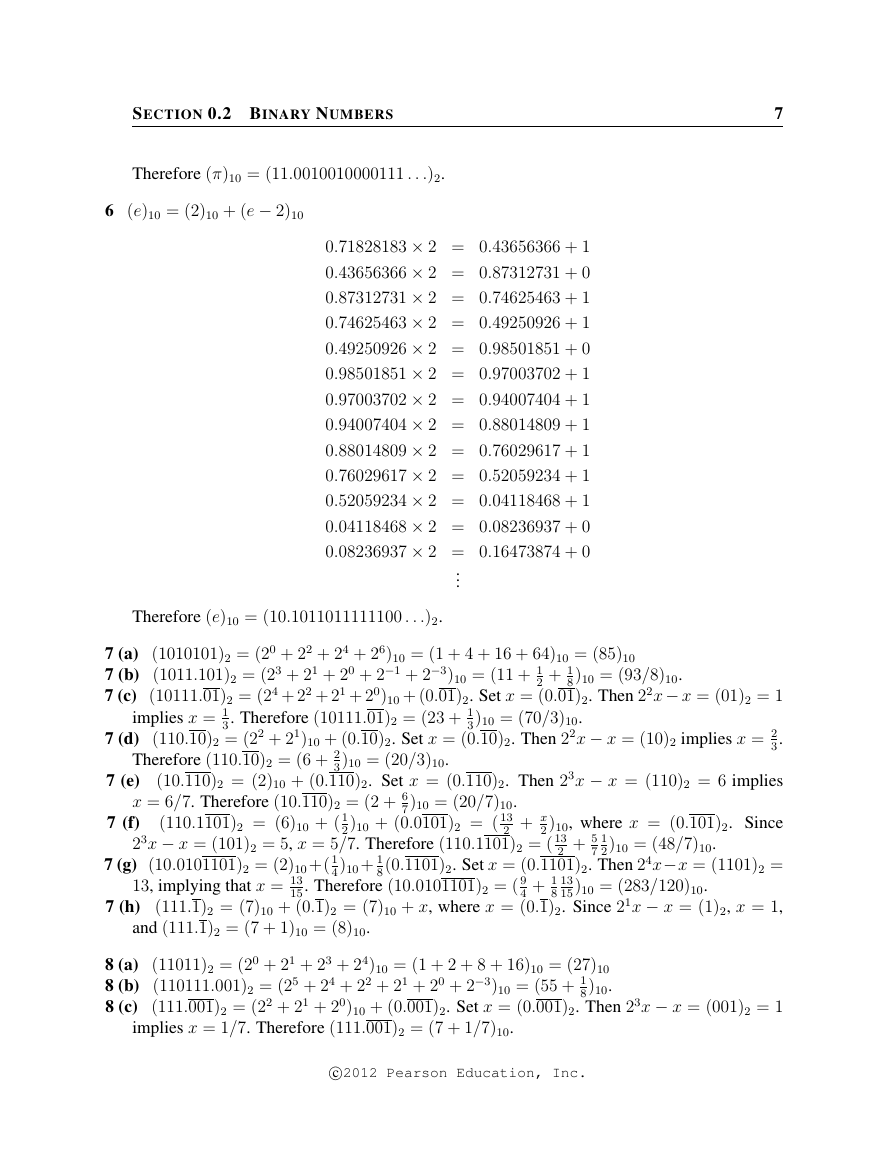
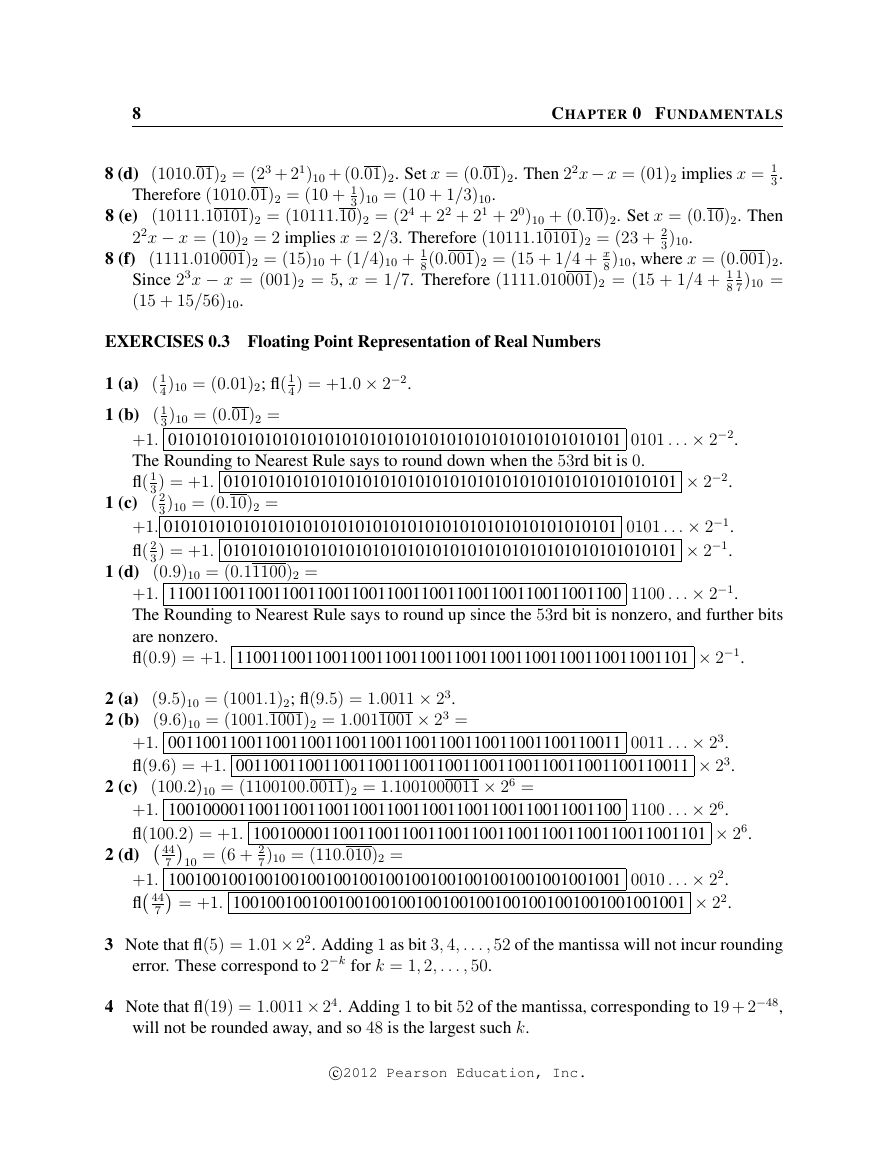








 2023年江西萍乡中考道德与法治真题及答案.doc
2023年江西萍乡中考道德与法治真题及答案.doc 2012年重庆南川中考生物真题及答案.doc
2012年重庆南川中考生物真题及答案.doc 2013年江西师范大学地理学综合及文艺理论基础考研真题.doc
2013年江西师范大学地理学综合及文艺理论基础考研真题.doc 2020年四川甘孜小升初语文真题及答案I卷.doc
2020年四川甘孜小升初语文真题及答案I卷.doc 2020年注册岩土工程师专业基础考试真题及答案.doc
2020年注册岩土工程师专业基础考试真题及答案.doc 2023-2024学年福建省厦门市九年级上学期数学月考试题及答案.doc
2023-2024学年福建省厦门市九年级上学期数学月考试题及答案.doc 2021-2022学年辽宁省沈阳市大东区九年级上学期语文期末试题及答案.doc
2021-2022学年辽宁省沈阳市大东区九年级上学期语文期末试题及答案.doc 2022-2023学年北京东城区初三第一学期物理期末试卷及答案.doc
2022-2023学年北京东城区初三第一学期物理期末试卷及答案.doc 2018上半年江西教师资格初中地理学科知识与教学能力真题及答案.doc
2018上半年江西教师资格初中地理学科知识与教学能力真题及答案.doc 2012年河北国家公务员申论考试真题及答案-省级.doc
2012年河北国家公务员申论考试真题及答案-省级.doc 2020-2021学年江苏省扬州市江都区邵樊片九年级上学期数学第一次质量检测试题及答案.doc
2020-2021学年江苏省扬州市江都区邵樊片九年级上学期数学第一次质量检测试题及答案.doc 2022下半年黑龙江教师资格证中学综合素质真题及答案.doc
2022下半年黑龙江教师资格证中学综合素质真题及答案.doc